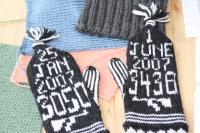Sex, knitting, potatoes and a Korean Godzilla - Bucharest’s international arts festival sneaks intothe capital’s museums, colleges and garages
 Scorned by City Hall and Government, Bucharest’s biannual arts festival has maximised its near-zero funding to allow international artists to undertake cerebral and surreal ventures in obscure public spaces.
Scorned by City Hall and Government, Bucharest’s biannual arts festival has maximised its near-zero funding to allow international artists to undertake cerebral and surreal ventures in obscure public spaces. Politics tops the agenda this year, with art as lecture, documentary, satire and protest, including attempts to show how the failure of financial structures undermines society.
On the surface, works which resemble a biological experiment, crafts workshop or travel guide disguise subversive intentions.
Potatoes grow in jars in Sweden’s Asa Sonjasdotter’s ‘Small Potatoes Make Big Noise’, where she nurtures hybrids from different areas of Romania - a fascinating allegory of regional differences in a country where near-famine is still within the memory of Romanians over 30.
Meanwhile Sabrina Gschwandtner’s mixed media ‘Wartime Knitting Circle 2007-2010’ reveals the relationship between protest, conflict and knitting - including gloves patterned with the number of US soldiers killed in Iraq, woven images of women making sticky bombs using a woolen exterior and directions on how to make socks for amputees.
‘Workarounds’ is a fascinating series of graphics which act as a ‘guidebook’ on how to survive in the West Bank. Compiled by Danes Lise Skou and Nis Romer, with students from the International Academy of Art Palestine, the images reveal how to cope in the heat, where to source drink and which roadside plants to eat, when trapped in queues at Israeli checkpoints.
Local artist Stefan Constantinescu reimagines Romania’s Communist past as a series of Socialist Realist style oil paintings of gymnasts, dancing children and obedient school-pupils – their lives clean, clear and regimented, but desensitised and lifeless.
But the main focus is on video art, such as diaries set to images and visual lectures, especially using archives from the Cold War. Swedish artist Magnas Bartas’s ‘Madame and Little boy’ introduces South Korean film actress Choi Eun-Hee, who was abducted by North Korea and forced to star a number of propagandist crowd-pleasers, including a Godzilla-style monster flick.
But when artists try to grapple with abuses in world economics, the result can be hopelessly academic. Zachary Formwalt’s ‘In place of capital’ shows similarities in development between photography and the Royal Exchange in London and Goldin+Senneby’s ‘Untitled’ is an essay, read aloud in an empty room, about price derivatives.
The Biennale succeeds when flipping spaces into a platform for art – such as a former bank, the corridors of the Institute of Political Research and a broken-down garage, fringed by ivy with a stray puppy in the courtyard.
But anyone hoping for gratuitous sexual imagery in a gallery dedicated to paleontology will be disappointed.
American Kaucylia Brooke’s 32 photos of inter-racial and same-sexual partnerships, ‘Tit for Twat: Can we talk? 1993-2010’ was censored by the Museum of Geology, where photos of female body parts reduced the staff to tears, causing the museum administrator to eject the pics from the premises.
Fear of a Stalinist coup of the Romanian cultural consciousness starting in the museum may be overstated - as still hanging in the building next to a table charting the Triassic to Cretaceous time periods is a photo montage of drag queens.
No comments:
Post a Comment